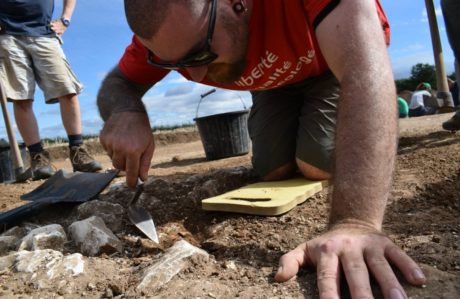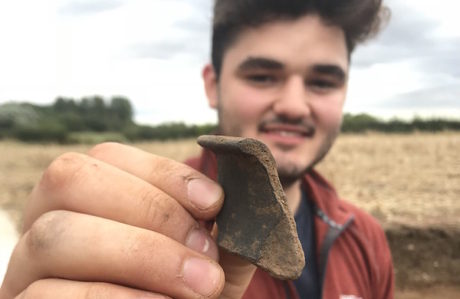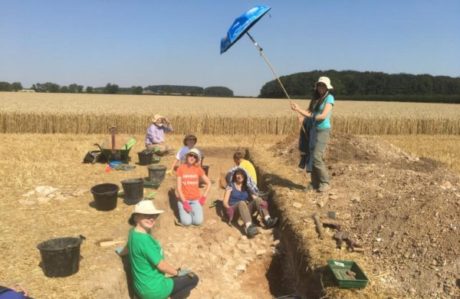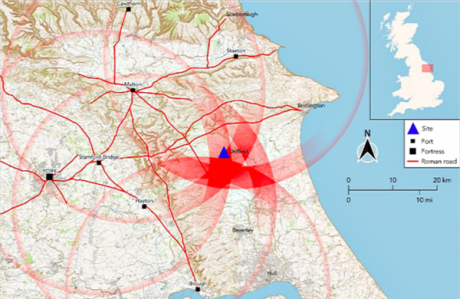
We’re ready to break the silence about our crowdfunded dig in East Yorkshire; with help from hundreds of archaeology enthusiasts, our excavation has uncovered one of the earliest Roman settlements ever to be discovered in the region.
Two thousand years ago, the Romans marched north and established a centre at York. But while archaeologists have found many later Roman settlements from the 3rd and 4th centuries AD, only a handful of sites inhabited by the earliest Roman settlers in the region have ever been found… until now.
Over the last two weeks, our crowdfunded excavation has revealed another one of these very rare, very early Roman sites.
The first sign that there might be something significant at this site came in 2015, when three metal detecting friends Paul King, Robert Hamer and Robin Siddle, uncovered a hoard of 18 silver coins. The friends reported the discovery to the Portable Antiquities Scheme, which encourages the recording of archaeological finds by the public.
![]()
Keeping the original discovery quiet until now has enabled us to plan a detailed archaeological investigation of the surrounding site and, with help from hundreds of crowdfunders, we were able to carry out a two-week excavation that has helped put the original discovery in context.
We now know that the hoard was just one small remnant of a much wider Roman settlement, which buildings, mosaics, more silver coins, hundreds of Roman pottery sherds, and a tiny brooch, found on one of three neonatal burials.
What’s more, with many of the finds dating to the middle of the first century AD, it appears to be one of the earliest Roman settlements ever discovered in Yorkshire.
Pottery
There were hundreds of Roman pottery sherds, including decorated bowls and amphorae, in which olive oil and wine would have been transported from the Mediterranean.
![]()
![]()
Among them were pieces of Samian ware, imprinted with delicate leaf patterns, fragments of Roman greyware, jug handles and pieces of large storage vessels.
Buildings and mosaics
The evidence at this site also includes post-holes, beautifully layered ditches and foundation trenches, with the remnants of stone walls that once stood there.
![]()
Evidence suggests there were one or two villas, while an extensive field-walking and metal-detecting survey of the surrounding area also brought back a significant number of mosaic tiles, or ‘tesserae’, adding to the impression that this settlement was pretty well-to-do.
![]()
A baby buried with a brooch
But while some of the discoveries were impressive, others were humbling. Excavation also revealed the individual burials of three small, neonatal babies, each carefully placed in their own grave.
![]()
Within one of the graves, our team also found a small, perfectly formed brooch – just small enough to have pinned together an infant’s cloak.
![]()
The discovery of neonatal burials at Roman sites is not uncommon, as parents of the time seem to have preferred burying their infants close to home, and provides further evidence that this was once a sizeable domestic settlement.
Roman coins
![]()
Archaeological excavation also revealed a few more silver coins, many dating to the time of the emperor Vespasian [AD 69–79], when the Romans finally marched north and established a centre at York. Along with other evidence, this suggests the settlement may be one of the earliest Roman sites ever discovered in Yorkshire.
![]()
This site is therefore of enormous importance to archaeologists, and is now being protected with a high level of surveillance.
What happens next?
Keeping quiet about the discoveries has been difficult, but doing so has enabled us to protect the site, explore it in greater detail, and recover wider evidence that can help us put the original metal-detecting discovery into context. But this is just the beginning…
With the excavation now over, it will soon be time to start analysing the finds. We’ll examine the pottery, the bones, the coins, the environmental samples, and put everything together to build up a chronology of the site, in order to help tell the bigger story of some of the first Romans settlers to establish a home in East Yorkshire.
![]()
Thank you to everyone who crowdfunded the dig, joined the excavation team and helped us unearth this important site. We couldn’t have made these discoveries without you!


